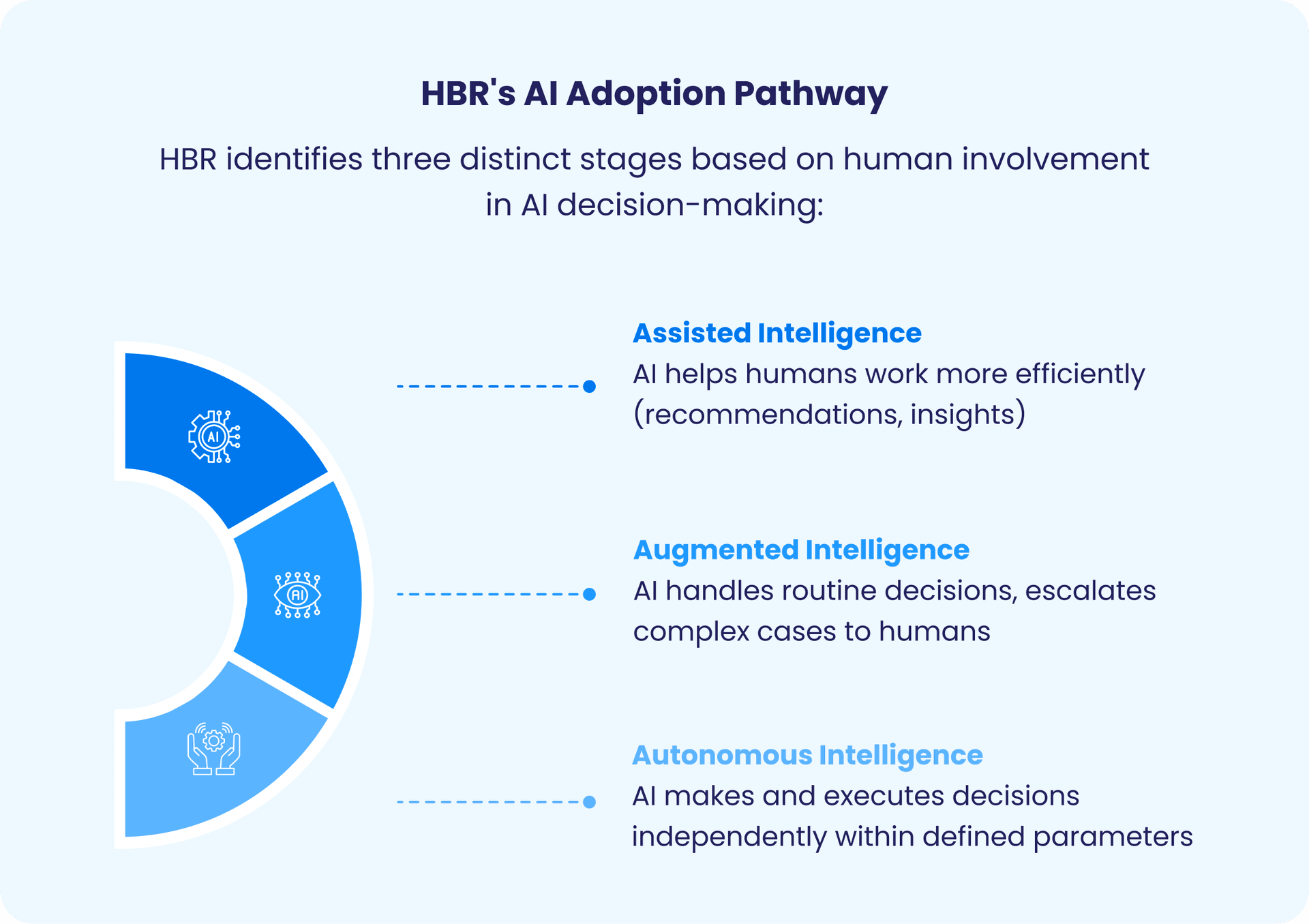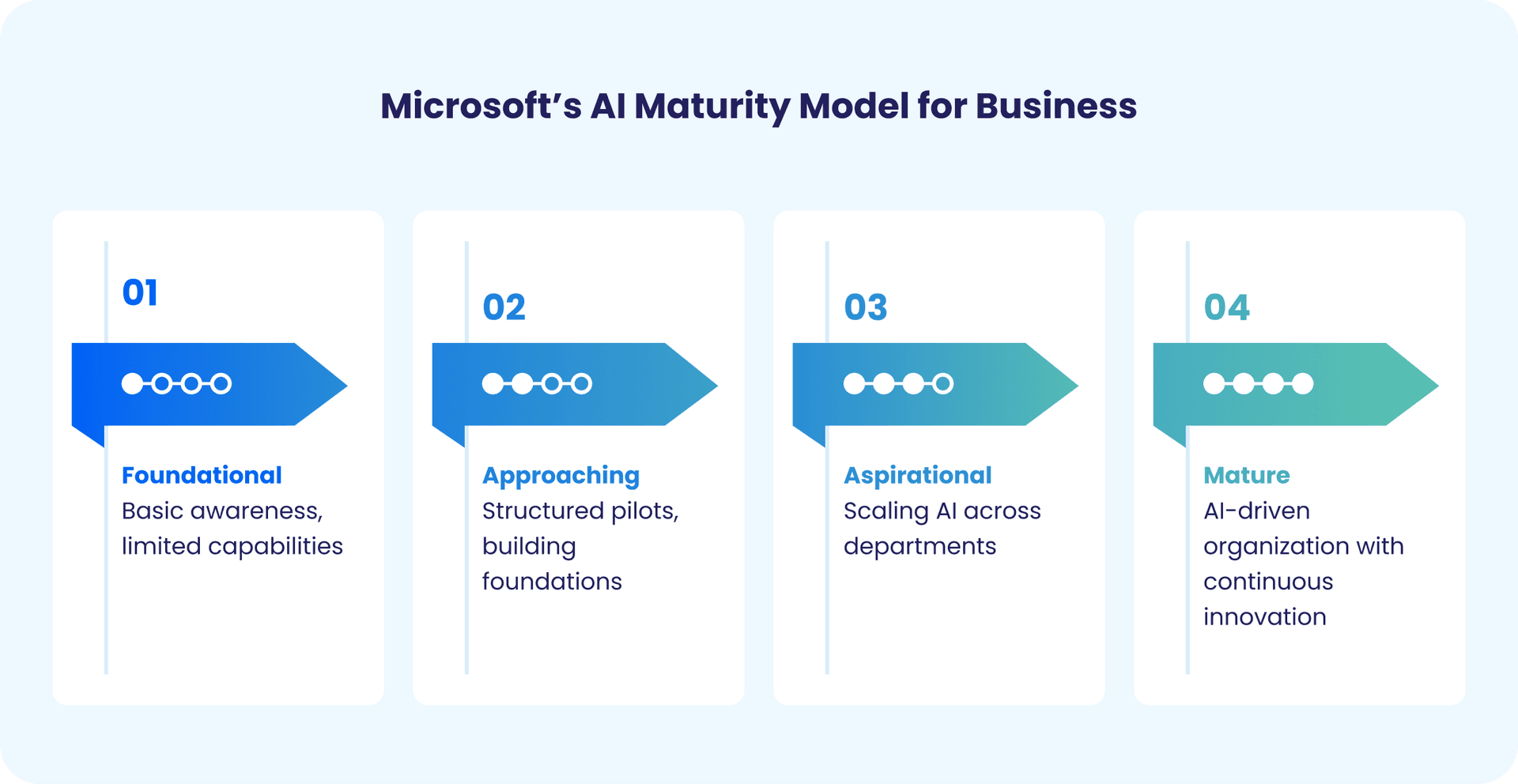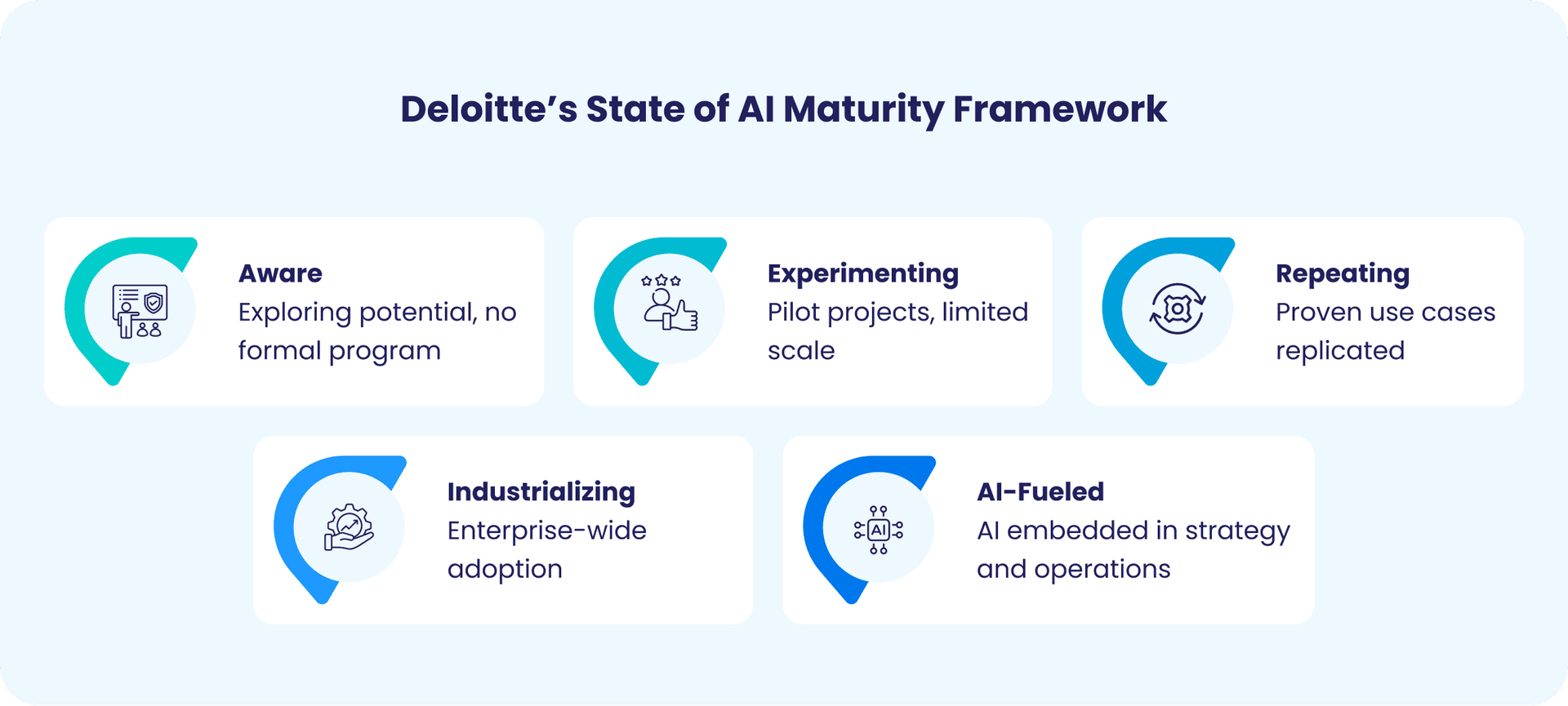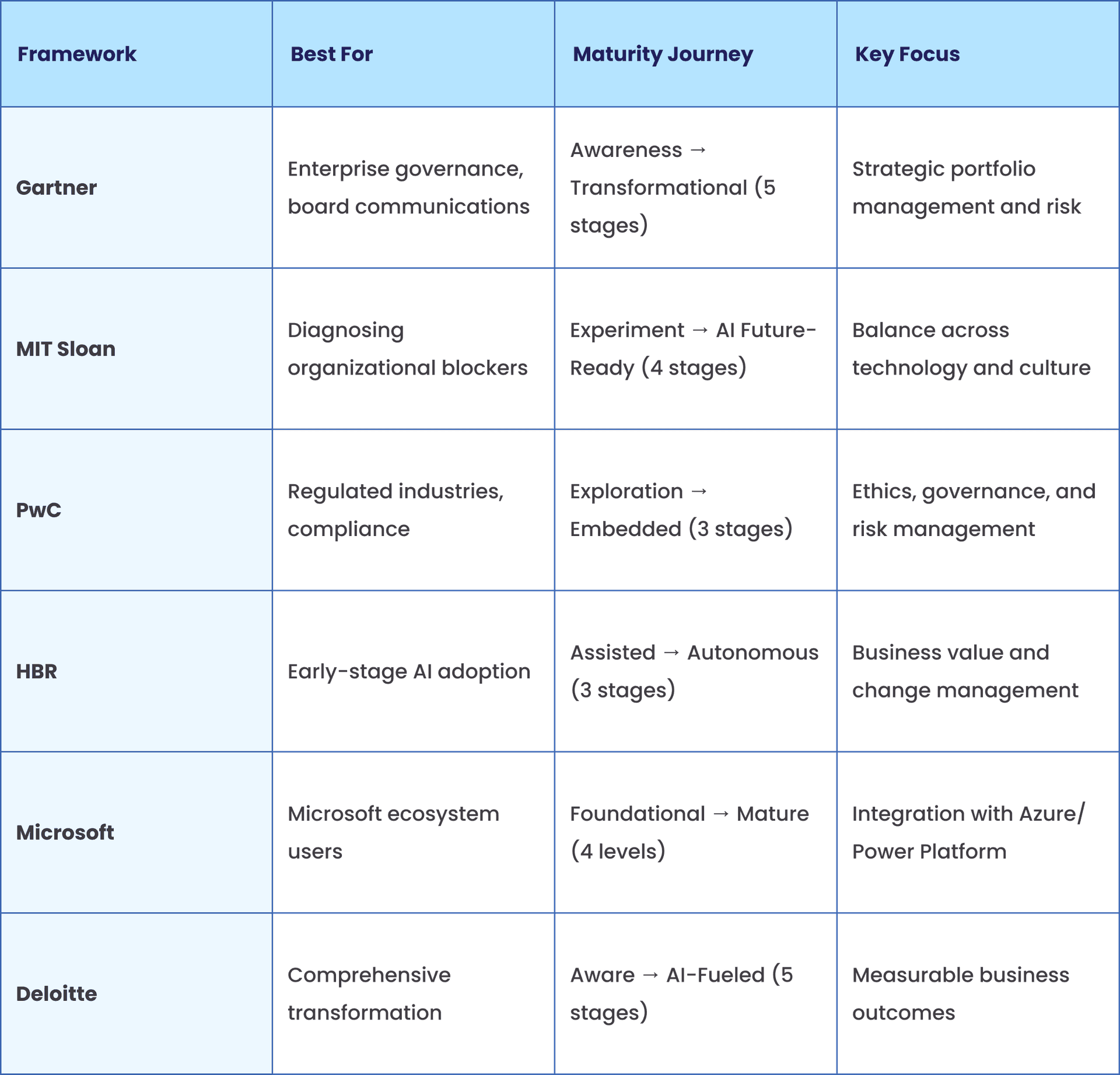The 6 Must-Know AI Frameworks for CIOs: Pick the Right Vendor in 2025

If you're evaluating AI vendors you're likely familiar with the flashy demos and big promises. But does that technology really fit your team and goals? According to Gartner, 60% of AI projects lacking AI-ready data will be abandoned by 2026, largely because organizations misjudge their maturity level or select solutions that do not fit their capabilities.
This article breaks down six established AI frameworks (Gartner, MIT, PwC, Harvard Business Review, Microsoft, and Deloitte) to help you assess your organization's AI maturity and choose vendors that match your objectives.
Why AI Maturity Frameworks Matter More Than Technology
The most expensive mistake in AI isn't buying the wrong technology—it's buying the right technology at the wrong time.
Consider this real example: A mid-sized financial services firm implemented autonomous AI for credit decisioning, inspired by JPMorgan Chase case studies. They invested $2.3M and 18 months pursuing fully autonomous intelligence. Their actual maturity? Early stage - inconsistent data quality, no machine learning operations (MLOps) infrastructure, and limited AI expertise. As a result, the project was eventually scaled back to basic AI-assisted recommendations, which is where they should have started. Cost of the maturity gap would reach $1.8M, and significant stakeholder confidence.
The core problem lies in the way organizations confuse where they want to be with where they are today. The gap between these two is where AI initiatives fail.
1. Where are we today?
Current maturity assessment, to help understand your baseline before planning forward.
2. Where can we realistically go next?
Determine the 'Adjacent possible', the next achievable step that keeps your strategy grounded and actionable.
3. What capabilities must we build to get there?
Identify technical, organizational and operational dependencies, priorities and necessary investment areas.
- The Adjacent Possible Rule: Your organization can reliably advance to the next maturity stage, but not jump multiple stages ahead. Stage 1 → Stage 2 is achievable with proper investment. Stage 1 → Stage 4 isn't possible without passing through stages 2 and 3, regardless of budget.
The 6 Essential AI Frameworks
1. Gartner's AI Maturity Model
- Best for: Enterprise-wide assessment and governance structure evaluation
Source: Gartner
Gartner structures AI maturity across five progressive levels: Awareness, Active, Operational, Systemic, and Transformational. Each level represents distinct capabilities in data management, model development, and organizational change.
- Key insight: Most organizations operate between level 2 (active pilots underway) and level 3 (AI running in production). If you're at level 2, purchasing technology designed for level 4 organizations creates an immediate capability gap that typically derails implementation.
Maturity progression:
- Awareness: Exploring AI potential, no formal initiative
- Active: Pilots underway, limited deployment
- Operational: AI in production, departmental focus
- Systemic: AI integrated across operations
- Transformational: AI drives business model innovation
- Use this framework when: Building business cases for AI infrastructure, establishing governance structures, or communicating strategy to boards and executives.
2. MIT Sloan's AI Maturity Framework
- Best for: Understanding the relationship between AI capability and organizational readiness
MIT evaluates maturity across four interconnected dimensions: AI Strategy Alignment, Data Foundation, Technology Infrastructure, and Organizational Factors (skills, culture, change management).
- Key insight: MIT's research reveals that high-performing AI organizations maintain balance across all four dimensions. Organizations that focus too heavily on technology while neglecting organizational factors consistently underperform those with balanced development.
Maturity progression:
- Experiment & Prepare: Limited pilots, building awareness
- Build Pilots & Capabilities: Structured experimentation
- Industrialize AI: Scale proven use cases
- AI Future-Ready: Continuous innovation culture
- Use this framework when: You're experiencing the maturity-ambition gap, attempting advanced AI capabilities without the foundational readiness. This framework excels at diagnosing which dimension is blocking your progress.
3. PwC's Responsible AI Framework
- Best for: Organizations prioritizing governance, ethics, and risk management.
PwC structures AI maturity through six pillars: Fairness & Bias Mitigation, Transparency & Explainability, Robustness & Security, Governance & Accountability, Privacy & Data Protection, and Human Control & Oversight.
- Key insight: With regulatory scrutiny increasing globally (EU AI Act, US state laws, industry-specific regulations), responsible AI practices have shifted from optional to mandatory. The level of sophistication and rigor you need in your AI systems depends on how critical the use case is.
Maturity progression:
- Exploration: Basic awareness of responsible AI principles
- Experimentation: Implementing initial controls
- Embedded: Responsible AI integrated into development lifecycle
- Use this framework when: Deploying AI in regulated industries (financial services, healthcare, government), making decisions that affect individuals, or preparing for compliance requirements.
4. Harvard Business Review's AI Adoption Pathway
- Best for: Business leaders focused on value realization and change management.

- Key insight: Organizations must progress sequentially through these stages. Each stage builds organizational capabilities required for the next:
- Assisted → Augmented: Builds trust in AI, develops interpretation skills, establishes data quality feedback loops
- Augmented → Autonomous: Develops confidence in AI decisions, establishes exception handling, builds organizational comfort with reduced human control
- Use this framework when: Sequencing AI initiatives, managing stakeholder expectations, or assessing readiness for autonomous AI systems. This framework's simplicity makes it ideal for executive communication.
5. Microsoft's AI Maturity Model for Business
- Best for: Organizations using or considering Microsoft's AI ecosystem.

Microsoft structures adoption around four levels (Foundational, Approaching, Aspirational, Mature) evaluated across seven dimensions: Strategy, Culture, Organization, Data, Technology, Governance, and Operations.
- Key insight: This framework naturally guides organizations toward Microsoft's technology ecosystem, from Azure AI services and Azure Machine Learning, to Power Platform AI capabilities. For organizations already committed to Microsoft infrastructure, it provides clear adoption pathways with specific technology recommendations.
- Use this framework when: Evaluating Microsoft AI services, standardizing on Microsoft infrastructure, or connecting your maturity assessment to specific technology choices.
6. Deloitte's State of AI Maturity Framework
- Best for: Comprehensive enterprise transformation with emphasis on value creation.

- Use this framework when: You need comprehensive enterprise assessment, are justifying major AI investments to leadership, want to connect maturity to business outcomes, or are benchmarking against industry peers.
Download Your Free AI Maturity Scorecard
Assess where your organization stands on the AI journey, and accelerate your digital transformation.
How to Choose the Right Framework for Your Organization
Quick Framework Comparison

When choosing an AI framework, CIOs should consider their organization’s goals, industry, and transformation stage. Each framework offers a unique lens—from governance and compliance to culture and infrastructure. For example, Gartner is ideal for board-level strategy and risk management, while MIT Sloan helps diagnose internal blockers that derail AI success. PwC and Deloitte focus on regulated environments and measurable outcomes, respectively, whereas HBR supports early adopters navigating change. Microsoft’s framework is best suited for organizations already embedded in its ecosystem.
- Pro tip: Use one primary framework for consistency, and supplement with others for specific needs—like combining Gartner for strategic oversight with PwC for governance.
The Bottom Line: Strategic Clarity Beats Sophisticated Technology
The AI vendor landscape will continue to grow more complex. New capabilities will emerge, promises will become more ambitious and the hype will intensify.
Amid this complexity, these six frameworks can provide clarity about where you actually stand and what you're actually ready for.
The organizations that succeed with AI won't necessarily have the most sophisticated technology, rather, they'll have the clearest understanding of their maturity, the most realistic roadmaps, and the best alignment between ambition and capability.

Ready to implement AI like a pro?
Explore tailored strategies for overcoming integration, governance and scalability challenges in your AI journey.
FAQs
Frequently Asked Questions

About the Author
Adil Rao
Engineering genius, Adil has a knack for turning complex challenges into seamless solutions. An avid reader and aspiring writer, he dreams of crafting his own captivating stories in the future.
Table of Contents
Newsletter Signup
Tomorrow's Tech & Leadership Insights in
Your Inbox






